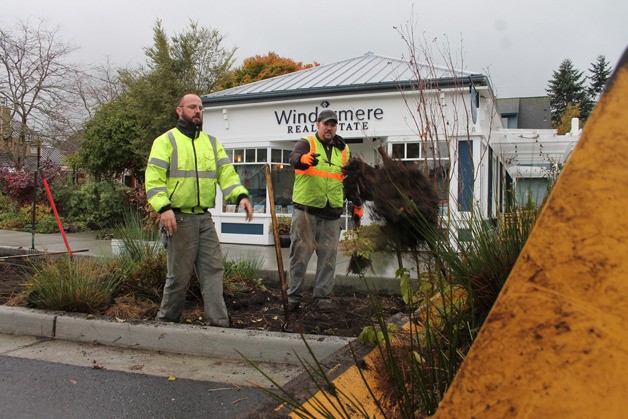Overgrown grasses and dead or dying vine maple trees on Second Street became enough of an eyesore that a Langley community organization has come forward and offered to redo the city garden on its own.
The Langley Main Street Association presented its design for renovating the garden that was only built and planted in June 2014. It was promptly approved by the city council and mayor at the council’s Nov. 2 meeting.
Janet Ploof, president of the association, said the group’s volunteers were prepared to remove the existing plants, tend to the soil and prepare it, plant new sedge and iris varieties, and put in a small pathway through the length of the garden. The new plants would be better selections for the space, she said.
“It doesn’t grow and flop over,” Ploof said at the council meeting.
The city council asked the mayor to make it happen at its meeting Monday. As of Thursday, city Public Works employees had removed the sedges and trees, leaving the 600-square-foot garden a long, brown streak of dirt.
Having an outside group take over a task that appeared to be solely in the domain of the city’s public works department was not unusual. Mayor Fred McCarthy and Public Works Director Stan Berryman said there has been a long history of cooperation between residents and the city, with some services provided by both. That includes Main Street.
“These are the people that put so much work into the other gardens and bumpout spaces, so the city can show its support,” McCarthy said.
Other cities have grappled with the worry over workers’ rights and having labor undermined by volunteer efforts. In Langley’s case, there was a legacy of shared responsibility between residents and government.
“We’ve had several collaborative projects with Main Street,” Berryman added.
The project was part of a $2.2 million redesign of Second Street between Anthes and Cascade avenues in 2014. The sidewalks were widened, a plaza in the middle of the road section was installed as a place-making feature in front of Callahan’s Firehouse, utility lines were replaced and a new road surface installed.
The rain garden was built by KPG, the firm contracted for the entire project. Located near the Anthes Avenue intersection, just in front of Windermere Real Estate and the Langley Village, storm water from Cascade Avenue flows down to Second Street and collects at the rain garden. Plants help store and filter it before rejoining the creek that lets out at Seawall Park.
As a rain garden, it functioned well, said McCarthy, when the issue first came to light in August. But after a prolonged hot and dry summer, the sedges grew long and could not support themselves erect. Falling over, the rain garden looked like an out-of-control lawn.
Even the mayor acknowledged that the rain garden, the only one in town not managed or planned by the Langley Main Street Association, looked out of place; the mayor called it the “poor stepsister.”
All of the new rain garden work will be accomplished for about $1,500, Ploof said. She asked the city to consider paying for the plants, which will be purchased at a discounted rate through one of its members. As with past tasks handled by the Langley Main Street Association, the money will be reimbursed from the city’s public works budget. There was enough money in 2015 coffers to cover the cost, said Berryman, and will not impact any other work in the city.
Berryman said the plant costs for the original vegetation are comparable to the Langley Main Street Association proposal.



